The Royal Shakespeare theatres
Shakespeare’s Birthplace
Mary Arden’s Farm
Anne Hathaway’s Cottage
Hall’s Croft
Shakespeare’s New Place
Holy Trinity Church
Shakespeare’s Schoolroom & Guildhall
Stratford-upon-Avon is a relatively small town so there is no need, for the purposes of this guide, to split it up into areas. The town is growing considerably and fast, however, and you need to penetrate some unremarkable outskirts that give no hint of the very attractive old centre. So many places in Stratford enjoy celebrating a Shakespeare connection that you half expect a plaque on the wall of a building exclaiming excitedly that the great man ‘may’ have been troubled by flatulence there. Every Tudor building in the town has the possibility of some sideways association.
The Royal Shakespeare theatres
This is where the strength of Stratford lies – in connecting with the powerful words of Shakespeare, watching a sublime performance of a play in an iconic setting and holding onto those memories forever.
If the reason you’re going to Stratford is for its connection to Shakespeare then the places, more than any other, that I would recommend visiting are the theatres, the home of the Royal Shakespeare Company (RSC). Just saying or writing the words gives me tingles down the spine. Ben Jonson, a friend and contemporary playwright of Shakespeare, once wrote about his work: ‘He was not of an age, but for all time!’ The theatres are the place to connect with the man and his work; they are where his efforts live on for all time.
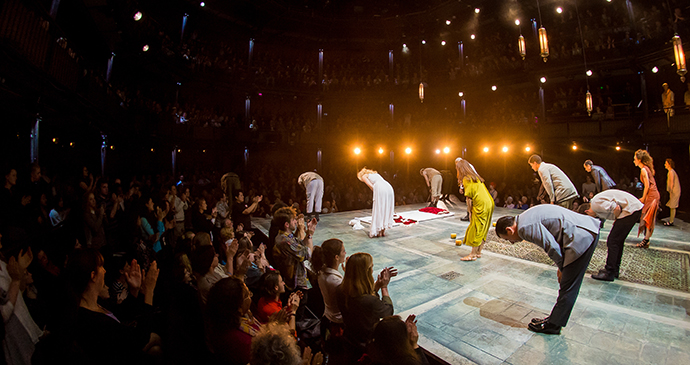
You don’t have to watch a production just because it’s the thing to do in Stratford, though I’d thoroughly recommend it. Just visit one of the theatres, look around the foyer, climb the Tower for views over the town or take a backstage tour and feel the energy and the excitement that the buildings create. The chances are that the more you discover about his work and how it fits the modern world, the more you will want to watch a production. The RSC is, after all, the master craftsman at Shakespeare’s plays.
Three performance spaces used by the RSC in Stratford are currently open to the public: the Royal Shakespeare Theatre (RST), the Swan Theatre and The Other Place. Despite the relatively recent transformation of the Royal Shakespeare Theatre, my favourite is still the beautiful Swan. Its intimacy and warm brick and timber structure is worthy of a visit regardless of whether you enjoy a Shakespeare production in there. Years back in my days as a young drama student dreaming of becoming a stage manager at the RSC, I would carry out work experience at the Swan, working alongside eminent lighting designers and technicians to change filters and watch productions from the lighting box. Even now, I feel energised as I enter the theatre and the first thing I do as I take my seat is to look up towards the lights – and as they fade and focus, I drink in the creative vitality of the space.
However, there are other ways to enjoy the theatres and make the most of the Royal Shakespeare Company’s presence. Look out for their open days and special events, which may include a football match between actors in the theatre garden, visits behind the scenes to the costume and scenery workshops or a hands-on demo about stage-fighting. Themed theatre tours are frequently available and there are regular talks about shows in production and frequent events for families and children. No age group is left out – the RSC is adamant that Shakespeare is accessible to all, from the very youngest of visitors.
I can vouch for that. My first visit to the RST was a production of Henry V at the age of four. I might not remember every detail, but I still have some enjoyable if vague memories of the show. And that, of course, is where the strength of Stratford lies – in connecting with the powerful words of Shakespeare, watching a sublime performance of a play in an iconic setting and holding onto those memories forever.
Shakespeare’s Birthplace
Its long road frontage woos many a foreign visitor for whom this moment might be the first time they have ever seen such a quaint-looking house.
Five houses are genuinely linked to Shakespeare. They include his birthplace and properties owned by him and his family. As some of the few remaining wattle-and-daub buildings left in the town, they tend to sit prominently along the street frontages. Most of the houses have events taking place throughout the year, from readings of the sonnets to outdoor plays, Tudor living history and children’s activities.
The beginning of the Shakespeare’s Way long-distance path to London, Shakespeare’s Birthplace is noticeably out of keeping with the remainder of the properties in Henley Street. Its long road frontage woos many a foreign visitor for whom this moment might be the first time they have ever seen such a quaint-looking house. Indeed, it is extremely striking for its antiquity both inside and out, and the garden in which it sits is kept beautifully.
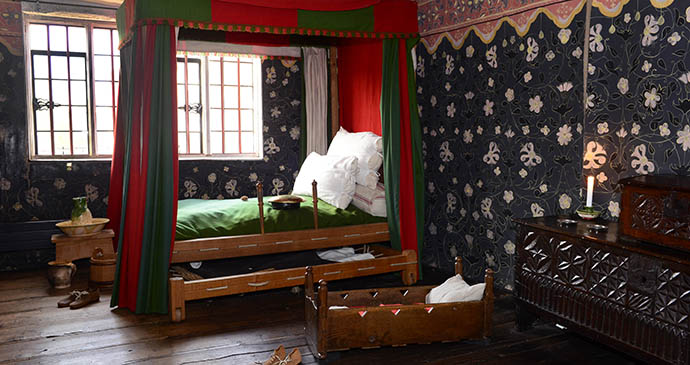
For me, however, the most interesting aspect is not the room in which Shakespeare was born in 1564, but the exhibition through which you pass in order to reach the house. Located in the adjacent Shakespeare Centre, it gives a quick run-down of Shakespeare’s life and, far from elevating him to dizzying heights beyond our grasp, proves him to be a human being. One who had to get married at the age of 18 (though this was quite usual in the period) because he’d got his girlfriend pregnant, one who was caught poaching deer in nearby Charlecote Park, fined for hoarding corn and one who was twice listed for tax evasion! There are poignant moments to pick up on too, such as the timing of his writing of Twelfth Night, a play about reuniting lost, believed dead, twins, shortly after the tragic death of one of his own children – also a twin. With a copy of the first folio of his plays from 1623, the exhibition finishes by explaining how Shakespeare has helped to shape us into who we are, illustrating some of the many phrases from his plays that are in common usage today.
Mary Arden’s Farm
The 16th-century farm has been brought to life with the sights, sounds and smells of the Tudor age.
Strictly speaking, the Shakespeare story begins some years before at the home of William’s grandparents and childhood home of his mother, Mary Arden. Mary Arden’s Farm is three miles from Stratford town centre in the tiny village of Wilmcote, so a bike is a useful addition to reach it. Alternatively, the City Sightseeing Bus calls at the entrance. The 16th-century farm has been brought to life with the sights, sounds and smells of the Tudor age. Daily routines, rare breed farm animals and home-grown ‘Tudor’ food cooked in the farmhouse kitchen give you an insight into past lives.
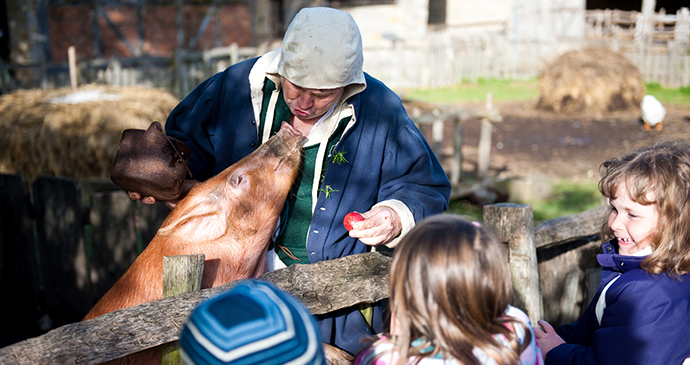
I asked my nine-year-old son what he thought of his visit: ‘The farm is made up of lots of little fields and I got to harvest flax with my hands. I liked the pigsty; it was made of straw and wood. I dressed up as a Tudor and got to make bread in the kitchen. The bread oven (he actually described it as a pizza oven!) was made by placing a basket onto a hard base, covering it with clay then burning the basket from beneath, leaving the clay oven. I did some Tudor dancing too and a man played the violin. I remember also that the side of the house nearest the road looked very neat and tidy compared to the rear, so that it looked “posher” than it really was.’
Anne Hathaway’s Cottage
Considered one of the most romantic of the Shakespeare houses, this is of course noted for being the place where the young and virile William wooed his future wife.
Tucked into a quiet lane in a little offshoot village of Stratford known as Shottery is Anne Hathaway’s Cottage, the childhood home of Shakespeare’s wife, Anne Hathaway. Considered one of the most romantic of the Shakespeare houses, this is of course noted for being the place where the young and virile William wooed his future wife. One can understand how Shakespeare would have easily been seduced by the timber and thatched property alone, for it is the setting of the house and its gardens that is so eye-catching. Old orchards surround the house and a small patch of woodland provides the perfect opportunity for a gentle walk through the dappled shade. There’s an Elizabethan-style yew maze and a living willow cabin where you can listen to the poet’s sonnets being read, but of particular note are the cottage gardens brimming with traditional floral scents and the allotment. It’s based upon Anne Hathaway’s vegetable patch and features a range of fruit and vegetables, the varieties of which date back to the 16th century.
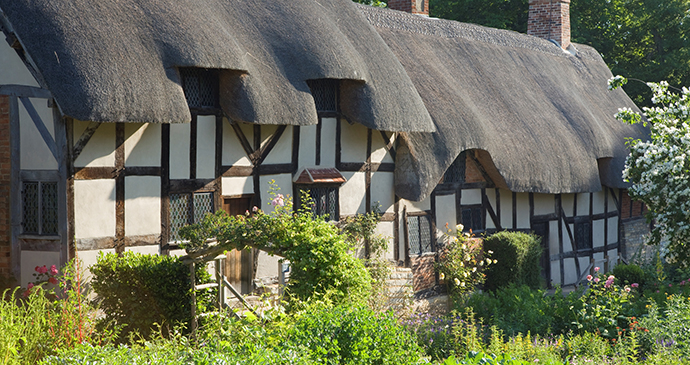
You can walk from the town centre along a pleasant, well-signposted, one-mile footpath to the cottage. The footpath entrance is at Evesham Place next to the Woodstock Guest House. Follow it straight on, crossing minor residential roads, to a large open playing field (Shottery Fields) and continue to the sign on the opposite side, pointing left or right to the cottage. The right-hand route is slightly more direct, but turn left (signposted Anne Hathaway’s Cottage via Shottery). Turn right on Shottery Road and follow it round, past thatched cottages and The Bell public house to a mini roundabout. Turn left into Cottage Lane and walk a short distance to the cottage on the left-hand side.
Hall’s Croft
Of all the five houses, this feels much more like a home than a museum.
Perhaps of all the Shakespeare houses, Hall’s Croft in Old Town has the least contiguous connection to William. By contrast to the throng of visitors to Shakespeare’s Birthplace, it also happens to be one of the quieter locations and is all the more pleasant for it. William’s daughter Susanna and her husband Dr John Hall, the only doctor in Stratford during his lifetime, owned the property, having had it built for them in 1613. Of all the five houses, this feels much more like a home than a museum. Forget patient confidentiality, you’ll find the doctor’s notes, his diagnoses and prescriptions along with the most nerve-wracking of medical implements. My favourite time of year is in the run-up to Christmas, when the house is decorated for a Tudor festive season and the scent of oranges, pomanders and Christmassy spices pervade the air. Take some time to sit in the peaceful walled garden, where you can breathe in the aromas of the medicinal herb garden.
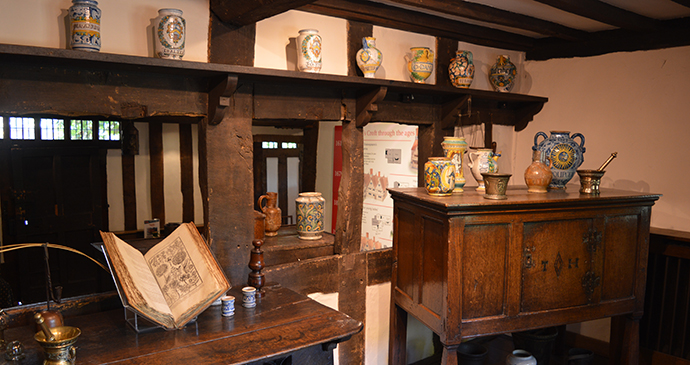
Shakespeare’s New Place
By 1597 Shakespeare had become really quite wealthy from his playwriting, so he bought the house with the grandest façade in town.
The Shakespeare story ends at a property on the corner of Chapel Lane and Chapel Street, right in the town centre. By 1597 Shakespeare had become really quite wealthy from his playwriting, so he bought the house with the grandest façade in town, Shakespeare’s New Place in Chapel Street, together with a cottage in Chapel Lane. Shakespeare’s New Place was a mansion and the second largest house in town. It was where he kept his library of books used as reference material for his work.
New Place is also where Shakespeare died in 1616, on 23 April – his 52nd birthday. His daughter Susanna later moved into the house with her husband Dr John Hall from their house in Old Town and the property was then passed on to Shakespeare’s granddaughter and her husband Thomas Nash.
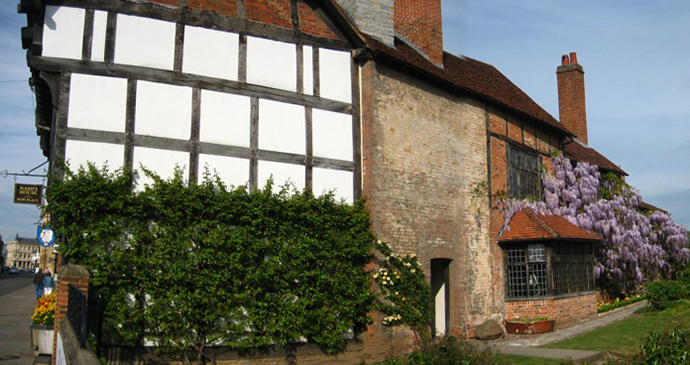
In 1759, irritated by the number of tourists appearing at the doorstep of his house eager to see where Shakespeare lived, the then owner Reverend Francis Gastrell demolished New Place and moved into the more modest timber-framed building next door, now known as Nash’s House, as it too had been owned by Thomas Nash. It’s this property that you enter, not New Place. However, you can wander the gardens and look at the foundations of the house that Shakespeare owned, completely reimagined through contemporary artwork and design in 2016 following a major archaeological excavation that uncovered notable finds. The gardens, including a formal Elizabethan knot garden and rampant hedges of fig and vine, are often bursting with colour, showing off the jumbled back of the surrounding houses.
Holy Trinity Church
Keen not to have his bones dug up and placed in a charnel house to make way for other incumbents, Shakespeare placed a curse upon his grave to ensure he could lay there in peace for eternity.
The spindly spire of what is known as ‘Shakespeare’s Church’ dominates the skyline of the southwest side of Stratford. This is where William Shakespeare was baptised and where he is buried, though you’ll find a hunt around the grounds for his gravestone fruitless. His final resting place is inside the church and you have to pay a small fee to view it and the memorial bust that sits above (although entrance to the church is free). His wife, daughter Susanna, son-in-law John Hall and grandson-in-law Thomas Nash are all buried in the chancel alongside him.
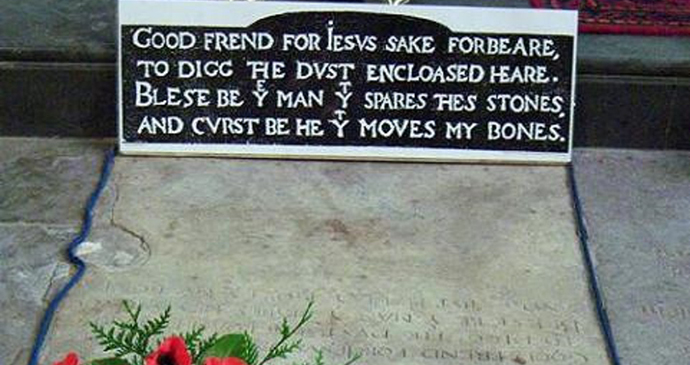
That William is granted a grave free from the ravages of weather is not owing to his status as the greatest playwright that ever lived. He paid for the privilege! Keen not to have his bones dug up and placed in a charnel house to make way for other incumbents, he placed a curse upon his grave to ensure he could lay there in peace for eternity. To date no-one has dared to test this curse.
The church sits in a peaceful part of town, its spire towering above the banks of the River Avon. There’s a pleasant riverside walk – and pilgrimage route – from the church to the RSC theatres.
Shakespeare’s Schoolroom & Guildhall
This is where, on the aging floorboards and back-aching forms, Shakespeare sat and listened to Greek tragedies, learnt Latin and watched the performances of professional theatre troupes scuttling around a tiny room.
Few schools of today can boast of possessing such historical buildings as King Edward VI Grammar School. But the long, low building that dominates Church Street is a heady mix of ancient timbers and the mirror-like sparkles of aging leaded windows. In some respects it’s just another rather lovely building, but it’s what this building represents that fires the imagination. For this is where William Shakespeare spent his formative years, 12 hours a day, six days a week for seven years. It’s where, on the aging floorboards and back-aching forms, he sat and listened to Greek tragedies, learnt Latin and watched the performances of professional theatre troupes scuttling around a tiny room.
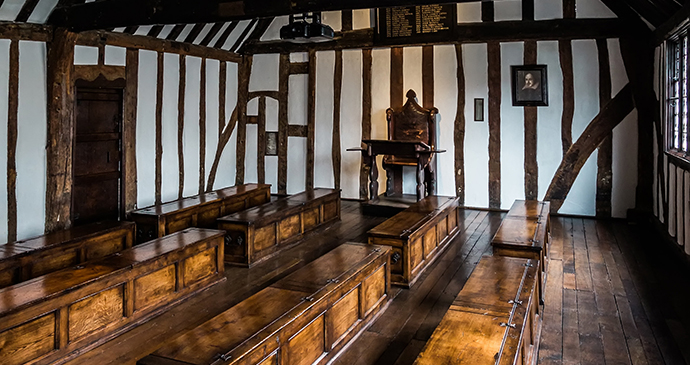
While the interior remains relatively bare, there’s plenty of information to digest here about Shakespeare’s education and there are numerous activities for children to do as they sit at sturdy wooden desks carved with the ancient graffiti of pupils distracted from their Latin verbs. But what I like about this building is not so much the knowledge that Master Shakespeare sat in this room for seven years but that it is still in use by the school; gold inscribed boards hang on the wall with the names of the school’s Head Boys and Girls and a morning meeting may well have taken place in the room before the tourist visitors arrive. It’s a living, breathing space.